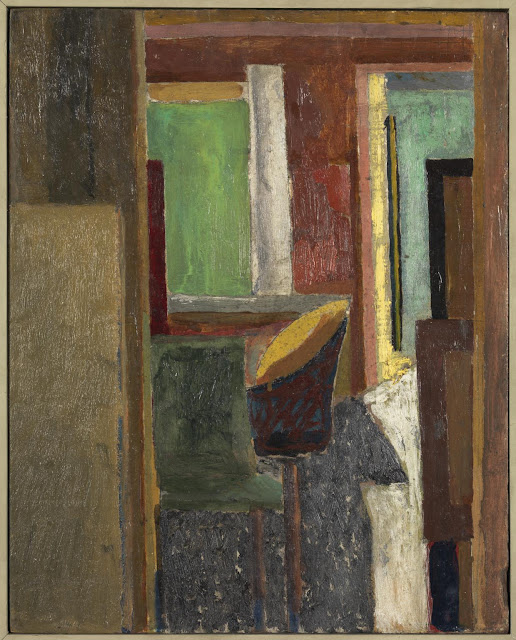 |
| Walter Sickert Two Women on a Sofa ca. 1903-04 oil on canvas Tate, London |
"In Venice in 1903-04 Sickert experimented with setting figures in natural poses in everyday surroundings. . . . Each figure looks back at the painter, one is bored, the other more relaxed. . . . Sickert's models were the prostitutes Carolina dell'Acqua and 'La Giuseppina'."
 |
| Walter Sickert The New Bedford ca. 1914-15 oil on canvas Tate, London |
 |
| Roger Fry Still-life: Flowers ca. 1912 oil on canvas Tate, London |
"Fry took up painting after an education in science at Cambridge. He was principally a writer on art, both on the old masters and the decorative arts, as well as modern painting. He encouraged an appreciation of Cézanne and the Cubists in Britain, and interpreted their art in terms of abstract form."
 |
| Roger Fry River with Poplars ca. 1912 oil on panel Tate, London |
"This view was painted from the bridge at Angles sur l'Anglin near Poitiers in France. Fry had discovered the painting of Paul Cézanne in 1906, the year of Cézanne's death, and had built an aesthetic theory largely based on the way Cézanne constructed his pictures. The style of this painting is like Cézanne in the suppression of detail, and in the organisation of the colouring into clear masses. The shapes are deliberately made to look solid, even the clouds and the banks of reeds in the river."
 |
| Ambrose McEvoy In a Mirror ca. 1911 watercolor Tate, London |
 |
| Ambrose McEvoy Two Ballet Dancers with Dresser ca. 1913 watercolor Tate, London |
"The early works of Ambrose McEvoy (1878-1927) are landscapes and interiors with figures in a style influenced by James McNeill Whistler. Later he gained success as a portrait painter, mainly of women and often in watercolour."
 |
| William Orpen The Model 1911 watercolor Tate, London |
"William Orpen (1878-1931) was a fine draughtsman and a popular, commercially successful painter of portraits for the well-to-do in Edwardian society, though many of his most striking paintings are self-portraits. . . . After his early death, a number of critics, including other artists, were loudly dismissive of his work and for many years his paintings were rarely exhibited, a situation that only began to change in the 1980s."
 |
| Duncan Grant Dancers ca. 1910-11 oil on panel Tate, London |
"In 1909 Duncan Grant visited the Paris studio of Matisse, whose Dancers may have partly inspired this painting. The vibrant colours and dynamic forms also reflect the influence of Gauguin, Cézanne and van Gogh. These were the chief artists introduced to British audiences through Roger Fry's Manet and the Post-Impressionists exhibition, which was held at the Grafton Galleries in London between 1910 and 1911."
 |
| Duncan Grant Interior at Gordon Square ca. 1915 oil on panel Tate, London |
"The Bloomsbury artists often focused their attention on their immediate surroundings, painting their friends engaged in such activities as painting, reading or writing, as well as the objects and furnishings (often home-made) in their rooms. This painting shows the view between the front and back rooms on the first floor of 46 Gordon Square in London where Grant lived for a time with Vanessa Bell; the front room was her studio. The composition shows that Grant was familiar with recent developments in France, such as Cubism."
 |
| David Bomberg Study for The Mud Bath 1914 watercolor Tate, London |
 |
| David Bomberg The Mud Bath 1914 oil on canvas Tate, London |
"The way in which Bomberg reduces the human figure to a series of geometric shapes may reflect his fascination with the machine age, derived from the Futurists and Vorticists. This painting could also represent the human form stripped to its essential core. The scene is based on steam baths near Bomberg's home in East London which were used by the local Jewish population and which also had religious associations."
 |
| Matthew Smith Fruit in a Dish ca. 1915 oil on canvas Tate, London |
"Matthew Smith (1879-1959) studied at the Manchester School of Art and at the Slade School of Art in London. Subsequently he studied under Henri Matisse in Paris and acquired an interest in Fauvism."
 |
| Matthew Smith Nude, Fitzroy Street, No. 1 1916 oil on canvas Tate, London |
 |
| Matthew Smith Apples 1919-20 oil on canvas Tate, London |
– quoted passages based on notes by curators at the Tate in London